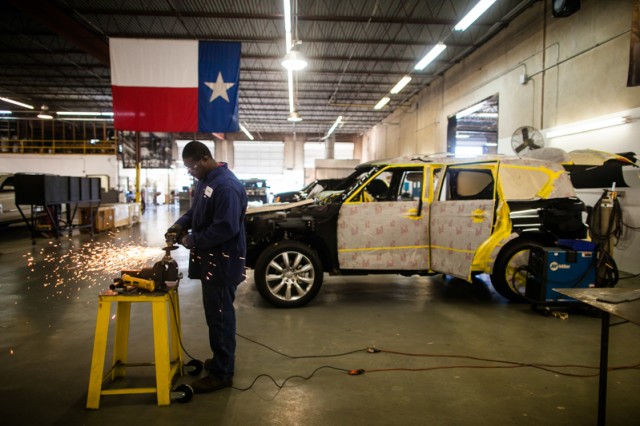Carjackings in Mexico Trigger Armored Car Sales in Texas

Dominic Mitchell grinds custom-made parts to outfit a Toyota SUV at the Texas Armoring Corporation in San Antonio, Texas, on October 17, 2014. Photo by Lukas Keapproth/Reporting Texas.
By Andy East
For Reporting Texas
Bulletproof car sales are on the rise in Texas as motorists react to evolving organized crime tactics in northern Mexico that have increased the risk of carjacking in recent years.
The cars, typically outfitted with bulletproof windows and cabins, electrified door handles and run-flat tire inserts, are designed to safeguard against carjacking and other attacks against vehicles, according to Trent Kimball, CEO and president of Texas Armoring Corp., a San Antonio-based armored car manufacturer that annually sells around 15 armored cars, worth nearly $2 million, along the Texas-Mexico border.
“We’ve seen a 50 percent increase in interest in the last six months to a year,” said Kimball.
Texas Armoring Corp. is one of several companies supplying armored vehicles to clients along the border. Canada-based INKAS Armored Car Manufacturers said in an email its presence is “growing tremendously.”
Mark Burton, CEO of Utah-based International Armoring Corp., said it sells 40 to 50 armored cars in the area annually. “Yes, the market is growing, but as it grows it seems to create more and more competitors,” Burton said.
Carjacking is a daily concern for Luz Quiroz, who lives in Laredo, a Rio Grande River town just across the border from Mexico. In November 2011, Quiroz was carjacked in her Honda CRV in Nuevo Laredo, Mexico, after stopping for ice cream just 1.5 miles south of the Rio Grande, according to a report filed with Nuevo Laredo authorities.
“I came back to my car and got in, and a young man approached and said, ‘Get out or I’ll kill you,’” Quiroz said. “Then he started to hit me in the face and another man came in from the other side and began hitting me, too. I’m not sure how I got out of the car, but I did. Then they drove away in my car. My face was swollen, I had two black eyes and bruised ribs.”
Sgt. Sergio Perez of the Brownsville Police Department Auto Theft Division said the stolen cars are rarely resold. Typically, organized crime groups such as Los Zetas and the Gulf Cartel use them to conduct a wide range of illegal activities, from transporting drugs and weapons to confronting local police.
“They use them for just about everything,” Perez said.
Quiroz said she later found her car, riddled with bullets, in a junkyard on the outskirts of Nuevo Laredo.
This year, as of October, Brownsville police have received 39 reports from Texans who said their vehicles had been stolen in Matamoros, Mexico — triple the number of reports received during the same period in 2013. El Paso police have reported 265 carjackings in neighboring Ciudad Juarez, Mexico, as of October. In August, the U.S. State Department updated its travel warning to northern Mexico, citing carjacking among several safety concerns. The warning said criminals have opened fire when they have met resistance.
Perez said the increased carjacking activity represents a shift in organized crime tactics. Car thieves used to boost cars in Texas and drive them to Mexico, where they could fetch between $1,000 and $2,000 a vehicle by selling them to organized crime groups. But in recent years, these groups have been cutting out the middleman, directly targeting motorists in Mexico. Although car thefts are typically nonviolent in the U.S., armed carjacking is a more common tactic in Mexico.
George Rivas of the State Department said there is no evidence to suggest U.S. citizens are being targeted for their nationality and recommends that motorists “travel during daylight hours and stick to the toll roads.”
Kimball said his customers are usually “businessmen or politicians or high-profile, wealthy individuals” who regularly cross the border and try to keep a low profile. The most common models his company sells along the border include the Toyota Tundra, Chevrolet Suburban and Chevrolet Silverado. Armoring a vehicle can cost from $40,000 to $185,000 and take three to six months, depending on the vehicle and level of protection the owner wants.
Add-ons range from a $7,550 night-vision system to $52,500 for additional armored protection against up to four pounds of C4 explosive or 20 hand grenades.
INKAS said in an email that one of the most expensive cars it has armored for a Texas customer is a Mercedes-Benz G63 limo, valued at $450,000. The Mercedes comes equipped with “heated and cooled leather seats with luxurious massage systems,” a bar and a safe. The company declined to identify the buyer.
Most customers are opting for discretion.
“They want to fly under the radar,” said Kimball. “So they get something that is not going to attract that much attention.”